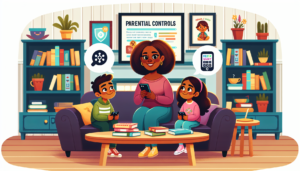What is Snapchat Sexting?
- Sending or receiving sexually explicit content, like photos or messages, via Snapchat.
Legal Risks:
- Illegal with Minors: Sexting anyone underage is against the law and carries serious legal consequences.
Privacy Concerns:
- Screenshots Can Be Taken: Even though Snapchat messages disappear, the recipient can still take a screenshot. This means photos/messages could be saved or shared without permission.
Discussion is key:
- Its important to discuss with teens about how sharing explicit content might impact future relationships, career, and reputation.
What Is Sexting?
Sexting is the act of sending sexually explicit messages, images, or videos through electronic communication, typically between mobile phones.
This behavior has become increasingly common among teenagers and young adults, but it is not limited to that age group.
The prevalence of smartphones and other digital devices has made it easier than ever for individuals to engage in sexting.
However, many people are still unsure of what exactly constitutes sexting and where the line is drawn between playful flirtation and inappropriate behavior.
In some cases, sexting can be a consensual and mutually enjoyable activity between partners, while in other instances it can lead to serious legal consequences, especially if the individuals involved are minors.
Understanding the risks and potential repercussions of sexting is crucial in order to make informed decisions about engaging in this behavior.
It is important for individuals to also consider the potential for their private content to be shared without their consent, leading to embarrassment, humiliation, and even legal ramifications.
Why Is Snapchat One Of The Most Used Apps For Sexting By Teens?
Snapchat is one of the most popular apps for sexting among teens for several reasons.
Firstly, the app’s disappearing messages feature makes it ideal for sending intimate content without the fear of it being permanently stored or shared.
This provides a sense of security and privacy for teens who are exploring their sexuality and want to experiment with sending risqué images.
Additionally, Snapchat’s in-app camera filters and features, such as the ability to draw and add text to photos, make it easy for teens to personalize and enhance their sexts before sending them.
The app also has a large and active user base, making it a convenient platform for teens to connect and engage in intimate communication.
Lastly, the app’s user-friendly interface and simple design make it accessible and easy to use for teens, who are often early adopters of new technology.
These factors combined make Snapchat a popular choice for sexting among teens.
However, it’s important for parents and guardians to educate their teens about the risks and potential consequences of sending explicit content online.
Stats About Teen Snapchat Sexting
According to recent statistics, teen Snapchat sexting is a prevalent issue in today’s society.
A survey conducted by the National Campaign to Prevent Teen and Unplanned Pregnancy found that 22% of teen girls and 18% of teen boys have sent nude or semi-nude images of themselves via Snapchat.
Additionally, a study by the Journal of the American Medical Association Pediatrics revealed that 14% of teens have received sexts, while 8% have forwarded them to someone else without the sender’s consent.
These troubling numbers highlight the ease with which teens can engage in risky behaviors and the potential for those behaviors to have long-lasting consequences.
While some may argue that sexting is a normal part of teenage sexual exploration, it’s essential to educate young people about the potential legal and emotional ramifications of such actions.
Parents, schools, and community organizations can play a vital role in providing guidance and support to teens as they navigate the complexities of sexual expression in the digital age.
5 REASONS WHY SNAPCHAT IS NOT SAFE FOR SEXTING
As Snapchat continues to be a popular platform for teenagers, there has been a significant increase in sexting behavior among this demographic.
According to recent statistics, there are numerous fake profiles on Snapchat, making it easier for individuals to engage in inappropriate behavior without fear of repercussion.
Once a photo is sent, it is essential to recognize that the sender loses control over it, as people have the capability to take screenshots and save the images for future use.
This leads to the potential risk of personal photos being leaked and exposed to a wider audience, resulting in potentially damaging consequences for the sender.
Furthermore, the act of sexting on Snapchat can leave individuals susceptible to blackmail by those with malicious intent.
The combination of the platform’s temporary nature and the false sense of security it provides has led to an increase in risky behavior among teenagers.
Education and awareness about the risks of engaging in sexting on Snapchat are essential for both teenagers and parents to ensure the safety and well-being of young individuals in the digital age.
It is crucial for teenagers to understand the potential outcomes of their actions when sending explicit photos and to use caution when interacting with others on social media platforms like Snapchat.
Teens need to be aware :
- There are lots of fake profiles on Snapchat
- Once you send a photo, you won’t have any control over it
- People can take screenshots of Snaps and save them for future use
- Your photos could be leaked and exposed for everyone to see
- You may get blackmailed by an evil-minded person
The combination of the platform’s temporary nature and the false sense of security it provides has led to an increase in risky behavior among teenagers.
Safe Lagoon stands as the digital guardian for over a million families.
It’s not just a tool; it’s peace of mind, ensuring kids’ screen time is both safe and balanced.
Simplicity meets security.
How your child can be exploited
Child exploitation can happen in various ways, including online, in person, and through labor.
Online exploitation occurs through social media, messaging apps, and online gaming platforms.
Predators may use these platforms to groom and manipulate children into sharing personal information, engaging in sexual conversations, or sending explicit images. In-person exploitation can occur through abduction, trafficking, or coercion by someone the child knows, such as a family member or authority figure.
Additionally, children can be exploited through labor by being forced to work in hazardous conditions, for little to no pay, or without proper education.
Children are often easily targeted for exploitation due to their vulnerability, lack of knowledge about the dangers, and inability to recognize exploitative situations.
It is crucial for parents to educate their children about potential dangers, monitor their online activities, and encourage open communication about any concerns or uncomfortable encounters.
Additionally, communities and governments play a critical role in preventing child exploitation by implementing policies to protect children, providing resources for at-risk families, and prosecuting those who exploit children.
By being informed and proactive, parents can help prevent their children from falling victim to exploitation and ensure their safety and well-being.
Signs Your Teen Might Be Snapchat Sexting
One sign that your teen might be Snapchat sexting is if they suddenly become overprotective of their phone or other devices.
This could mean that they are trying to hide something from you, such as inappropriate messages or photos.
Another clue to watch out for is if your teen is constantly checking their phone or seems overly preoccupied with the app.
If they are spending an excessive amount of time on Snapchat, it could be a sign that they are engaging in sexting behavior.
Additionally, if you notice a sudden change in your teen’s behavior, such as becoming secretive or withdrawn, it could be a red flag that something is going on.
Other signs to look for include your teen receiving gifts or money from unknown sources, as this could indicate that they are being incentivized to send explicit content.
It’s important to have open and honest conversations with your teen about the dangers of sexting and to establish rules and boundaries when it comes to their online activity.
Keep an eye out for these signs and be proactive in addressing any concerning behavior with your teen:
Overly-Protective Of Their Cellphone
When your teen becomes overly protective of their cellphone, it can be a sign that they are engaging in secretive behavior, possibly even Snapchat sexting.
They may guard their phone at all times, refuse to let anyone else use it, or quickly close out of apps when someone approaches.
This kind of behavior can be a red flag for secretive communication, such as sexting, and may indicate that they are trying to hide something.
Increased Secrecy Might indicate Snapchat Sexting
If you notice increased secrecy around your teen’s use of their smartphone, particularly with the application Snapchat, it could be a sign of sexting.
As we have discussed, Snapchat is known for its disappearing messages and the ability to send explicit photos that can quickly vanish, making it a popular choice for sexting.
If you notice a sudden change in your teen’s behavior, such as becoming secretive or withdrawn, it could be a red flag that something is going on.
New Friend Circle
When someone suddenly starts hanging out with a new online group of friends, it could potentially indicate involvement in Snapchat sexting.
The app allows users to send disappearing photos and videos, making it a popular platform for exchanging explicit content.
If a person is constantly meeting new friends and engaging in secretive behavior on Snapchat, it may be a red flag for sexting activity.
Risky Behaviors
The quick and temporary nature of Snapchat messages may make individuals feel more confident in engaging in risky behaviors, thinking that the messages will disappear after being viewed.
Spending Lots Of Time On Snapchat
Spending a significant amount of time on Snapchat can be a sign that someone is engaging in Snapchat sexting.
In some cases, excessive use of Snapchat and frequent messaging to multiple contacts can indicate a pattern of sexting behavior. It’s important to be mindful of the amount of time spent on social media platforms and to carefully consider the nature of the content being shared and received.
A Drop In School Performance
A sudden drop in school performance could be a sign that a student is engaging in Snapchat sexting.
With the prevalence of smartphones and social media, students are increasingly using platforms like Snapchat to send explicit messages and photos.
This can not only distract them from their studies, but also lead to emotional and psychological stress.
Parents and teachers should be vigilant for signs of a decline in academic performance and be proactive in addressing the issue.
Open communication and education about the potential consequences of sexting can help students make more responsible decisions and prioritize their education.
A Noticeable Change In Sleeping Pattern
If you notice a sudden change in your teen’s sleeping pattern, it could be a sign that they are engaging in Snapchat sexting.
Teens who are involved in sexting often stay up late at night to have private conversations with others.
They may also show signs of fatigue during the day due to lack of sleep.
Keep an eye out for unusual sleeping habits, such as staying up much later than usual or being excessively tired during the daytime.
These changes in sleeping patterns could be a red flag for someone who is participating in sexting activities on social media platforms like Snapchat.
Other signs to look for include your teen receiving gifts or money from unknown sources, as this could indicate that they are being incentivized to send explicit content.
What To Do If Your Teenager Is Snapchat Sexting?
If you suspect that your teenager is Snapchat sexting, it’s important to address the situation immediately.
Start by having an open and honest conversation with your teen.
Let them know that what they are doing is not only risky, but also illegal.
Emphasize the potential long-term consequences, such as damaging their reputation, impacting future employment opportunities, and even facing legal charges.
Encourage your teenager to delete any inappropriate photos or messages they have sent or received, and to have a serious talk with the person they were communicating with about the dangers of sexting.
Additionally, consider implementing stricter monitoring of your teen’s online activities, such as requiring them to provide you with their login information or using parental control software.
It’s also important to educate your teenager about the potential dangers of online communication and the importance of respecting both themselves and others.
Seek outside help if necessary, such as talking to a school counselor or seeking therapy for your teenager.
Remember to approach the situation with empathy and understanding, as your teenager may be feeling embarrassed, scared, or unsure of how to handle the situation.
By addressing the issue promptly and providing support, you can help steer your teenager away from engaging in risky behavior and guide them towards making better choices in the future.
How to Talk to Your Kid About Snapchat Sexting
If you discover that your teenager is engaging in Snapchat sexting, it’s important to address the situation immediately and with care.
Start by calmly discussing the issue with your teenager and explaining the potential risks and consequences of sexting.
Emphasize the importance of respecting themselves and others, and the permanence of digital content.
It’s crucial to approach the conversation with empathy and understanding, as shaming or blaming could lead to your teenager closing off and continuing the behavior in secret.
It’s also important to establish clear boundaries and consequences for their actions, while also offering support and guidance.
Consider setting limits on their technology use and monitoring their online activity.
Encourage them to seek healthy and respectful ways to express themselves and communicate with others.
It may also be beneficial to involve a mental health professional to provide additional support and guidance.
Additionally, it’s important to educate your teenager about the laws and potential legal consequences of sexting, as well as the impact it could have on their future, including college and job prospects.
Encourage them to think before sharing anything online and to choose positive and constructive ways to interact with others.
It’s essential to offer ongoing support and communication to help your teenager navigate through this difficult situation and prevent further sexting behavior.
How to help keep your child safe on Snapchat
Snapchat can be a fun way for your child to connect with friends, but it’s important to take steps to keep them safe while using the app.
The first thing you can do is talk to your child about the potential dangers of sharing personal information online.
Make sure they understand the importance of keeping their private information, such as their address and phone number, private.
It’s also important to set privacy settings on their account, limiting who can send them messages and view their stories.
You can also encourage your child to only add and accept friend requests from people they know in real life.
Another way to help keep your child safe on Snapchat is to monitor their activity on the app.
Consider adding them as a friend and regularly checking their snaps and conversations.
It’s also a good idea to educate your child about inappropriate or harmful content and encourage them to come to you if they ever encounter something that makes them uncomfortable.
Additionally, make sure your child knows how to block and report users who are behaving inappropriately.
Lastly, it’s important to have open and ongoing conversations with your child about their experiences on Snapchat and the internet in general.
By staying involved and informed, you can help ensure that your child stays safe while using the app.
Snapchat Sexting FAQ
Yes, Snapchat is private to an extent.
The app’s core functionality revolves around sending disappearing photos and videos which are only visible for a limited time to the recipient.
Users can also choose to send “private” snaps and messages to specific friends, which are only accessible by those selected contacts.
Additionally, Snapchat offers privacy features such as the ability to customize who can view your story and the option to block or remove friends if desired.
However, it’s important to note that while Snapchat does offer privacy settings, it is still a social media platform and anything shared on the app has the potential to be screenshotted, saved, or shared by the recipient.
Therefore, it’s important for users to be mindful of what they choose to share on the platform.
The app is designed to automatically delete messages and photos after they’ve been viewed, but there’s always a chance they could be saved or screenshot by the recipient and potentially shared without the sender’s consent.
Additionally, there have been security breaches in the past that have put users’ data at risk.
While Snapchat has taken steps to improve its privacy and security features, it’s important to consider the potential risks before sending private photos through the app.
Ultimately, it’s important for users to be cautious and mindful of who they share sensitive information with, regardless of the platform.
Sexting on Snapchat can be considered a crime if it involves sending explicit or pornographic materials to someone who is underaged.
In many jurisdictions, this behavior is classified as distributing child pornography, which is illegal and can lead to serious legal consequences.
Even if both parties involved are of legal age, sharing private and intimate materials without the other person’s consent can still be considered a violation of privacy laws.
It’s important to be aware of the legal implications of sexting and to always obtain consent before sharing any sensitive content on social media platforms like Snapchat.
If someone is sending inappropriate pictures on Snapchat, it is important to report them to the platform.
To do this, you can go to the chat with the person who sent the inappropriate pictures, tap on their Bitmoji or profile icon, and then tap the three dots in the top right corner.
From there, you can select “Report” and choose the reason for the report, such as “It’s inappropriate” or “I don’t want to see this.”
Snapchat takes these reports seriously and will take action against the offender if necessary.
It’s important to keep the platform safe for everyone and to speak up if you encounter inappropriate behavior.
Yes, Snapchat has the capability to see your Snaps.
While the company claims that they do not store or access the content of your Snaps, they also state that certain forms of the content can be stored on their servers for a limited period of time.
The content can be accessed by Snapchat employees for the purpose of maintaining the app and ensuring its proper functionality.
Additionally, Snapchat also has the right to disclose your Snaps to law enforcement or other third parties if they believe it is necessary to comply with a legal obligation.
So, while Snapchat claims to respect the privacy of your Snaps, there is still the potential for them to access and view the content.





